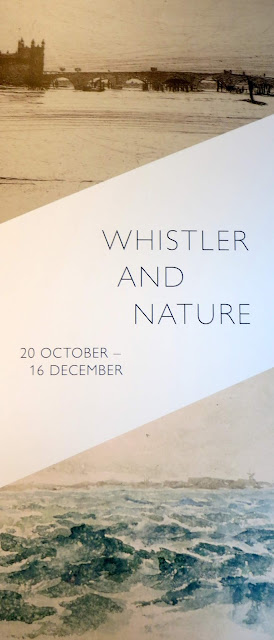Whistler and Nature,

at Compton Verney, Warwickshire.
With the exception of the odd oil painting, this is an exhibition of works on paper spanning five decades of Whistler's career. Whistler's smoky images of warehouses, harbours and industrial scenes were designed to showcase a new kind of productive, wealth-generating landscape for the modern Victorian age; a view of nature constrained by human-made structures and urban life.
As Alastair Smart in the Telegraph pointed out, Whistler is perhaps best known for his Nocturnes: hazily evocative, night-time scenes that anticipated abstraction. (Ruskin compared Whistler's selling one of these, 1875's Nocturne in Black and Gold: The Falling Rocket, to 'flinging a pot of paint in the public's face'). A Nocturne canvas is included here, but more germane are the prints of Venice from 1880.
The title of the exhibition is misleading, as the show comprises many works that have nothing to do with nature.

Battersea Reach from Lindsey Houses, 1864-71, (oil on canvas)
By the 1860s, heavy London fogs such as the one shown here were being caused by the effects of coal fires and industrial pollution. Whistler claimed to be the first painter to make London fogs a special subject in its own right; certainly they served to give him the spatial ambivalence he always sought.
The parasols also give the women in the foreground an air of japonisme so fashionable in the 1860s - their dresses could almost be mistaken for kimonos.

The Pool, 1859, (etching)
The Balcony, 1880, (etching and drypoint)
Nocturne, 1875-77, (oil on canvas)
Whistler explained his use of the term 'Nocturne' (which normally denotes a musical composition played in the evening or evocative of night) by declaring that 'I wished to indicate an artistic interest alone, divesting the picture of any outside anecdotal interest which might have been otherwise attached to it. A nocturne is an arrangement of line form and colour first. The picture is throughout a problem that I attempted to solve. I made use of any means, any incident or object in nature that will bring about this symmetrical result'.
This evocative view, showing two barges in sail in the centre of the river, may have been composed from an upstairs window of Whistler's house at Lindsey Row, overlooking the newly-built Chelsea Embankment.
Nocturne: Palaces, 1880, (etching and drypoint)
Upright Venice, 1879-80, (etching and drypoint)

Nocturne: Furnace, 1880, (etching and drypoint)

The Traghetto, No. 2, 1880, (etching and drypoint)

Black Lion Wharf, 1859, (etching)

Thames Warehouses, 1859 (etching)

Two Breton Women Knitting, 1893, (watercolour on paper)
Whistler's use of areas of dampened paper combined with delicate brushwork is characteristic of his watercolour work of this period.

Grey and Silver - North Sea, 1884, (watercolour on paper)
Sketch for The Balcony, 1867-70, (oil on panel)
This was derived from two woodcuts by Torii Kiyonaga; indeed, the rolled bamboo blinds and the suggestion of oriental costume give the picture a distinct air of japonisme. Whistler worked on the composition for a long time intending to enlarge it to send to the Paris Salon exhibition. Yet he never seemed satisfied with it. The Japanese-looking blossoms in the foreground were a late addition.

Off the Dutch Coast, 1883-4, (watercolour on paper)
Beach Scene with a Breakwater, 1899, (watercolour on paper)
Grey and Pearl: Bank Holiday Banners, 1883-4, (watercolour on paper)
Blue and Brown: Westgate-on-Sea, 1883-4, (watercolour on paper)

Harmony in Blue and Silver: Trouville, 1865, (oil on canvas)










No comments:
Post a Comment